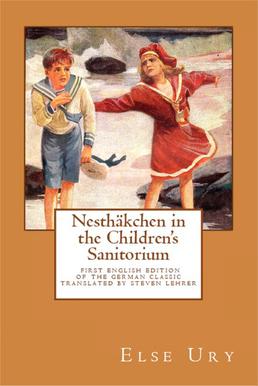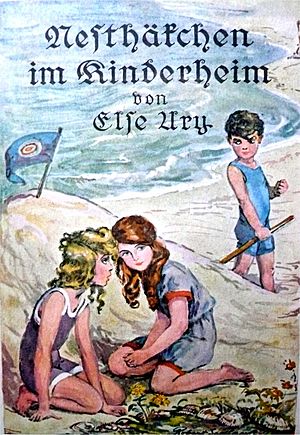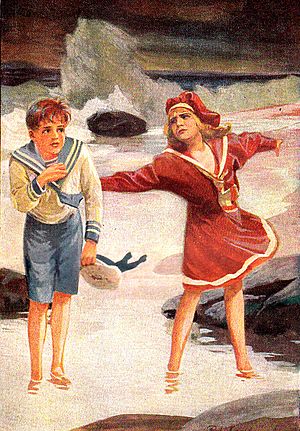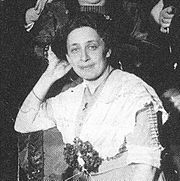Nesthäkchen in the Children's Sanitorium facts for kids
 |
|
| Author | Else Ury |
|---|---|
| Original title | Nesthäkchen im Kinderheim |
| Translator | Steven Lehrer |
| Illustrator | Robert Sedlacek |
| Country | United States |
| Language | English |
| Series | Nesthäkchen, volume 3 |
| Genre | Fiction/Adventure |
| Publisher | SF Tafel |
|
Publication date
|
2014 |
| Media type | Print (Trade Paper) |
| Pages | 210 pp (Trade Paper edition) |
| ISBN | 1500424587 |
| Preceded by | Nesthäkchen's First School Year |
| Followed by | Nesthäkchen and the World War |
Meet Annemarie Braun, a lively German girl from Berlin. She's the main character in the Nesthäkchen book series by Else Ury. This series follows Annemarie from when she was a baby all the way to old age. This third book, published in 1915 or 1921, is about Annemarie when she's ten years old. It tells how she gets sick, recovers at a special children's home, and tries to get back home when a big war starts.
Contents
Annemarie's Island Adventure

In this book, Annemarie Braun is ten years old. She is a very active child and does well in school. One day, she gets a high fever at school. Her father, who is a doctor, accidentally passed scarlet fever to her. He had just examined other children with the illness.
After a long time recovering at her father's clinic, Annemarie is still very weak. So, her parents send her away for a year. She goes to a children's special recovery home called "Villa Daheim." This home is on the North Sea island of Amrum, in a town called Wittdün. A sea captain's widow, Mrs. Clarsen, and her sister Lina run the home.
Life on the island is very different. The book describes the landscape, the local customs, and how people dress and speak. The people there speak a language called Plattdeutsch (Low German). Annemarie makes new friends, including a mischievous boy named Peter. Peter often gets into trouble.
A Dangerous Storm
Annemarie and Peter go on an adventure together. They walk into the muddy areas, looking for treasures. They wander off the safe path and get caught in a sudden storm. The water starts to rise around them. It's a very dangerous situation! But they manage to find their way out and get to safety.
Annemarie also becomes friends with a kind girl named Gerda. Gerda has a problem with her leg and can't walk well. Another boy, Kurt, is also at the home. Annemarie met Kurt before in the hospital in Berlin. Kurt uses a wheelchair. With a lot of patience and Annemarie's help, Kurt slowly learns to walk again.
War Breaks Out
At the end of the story, Annemarie is eleven years old. The First World War suddenly begins. Everyone staying at the children's home has to leave the island very quickly. As Annemarie is leaving, her favorite doll, Gerda, falls into the water from the pier. This moment is very sad. It shows that Annemarie's childhood is now ending.
How the Story Changed
This book has been changed many times over the years. In the first versions, Annemarie's school year was counted differently. Also, her friend Gerda was originally from a city called Breslau. After 1945, in newer editions, Gerda was said to be from Munich.
In the first book, a real princess named Princess Heinrich visited the island. In later books, this princess was changed to a young queen from Denmark. These changes were made to update the story for new readers.
What Kind of Book Is It?
The Nesthäkchen books belong to a German type of story called a Backfischroman. This means "teenage girl novel." These books were popular between 1850 and 1950. They were written for girls aged 12 to 16.
Backfischroman stories usually showed girls growing up and learning about society's rules. Often, the stories ended with the main character getting married and becoming a homemaker. Besides Else Ury, other famous authors of these books included Magda Trott and Emmy von Rhoden.
Else Ury first planned to end the Nesthäkchen series after six books. The sixth book, Nesthäkchen Flies From the Nest, was about Annemarie getting married. But Ury's publisher received many letters from young fans. They begged for more Nesthäkchen stories! So, Else Ury wrote four more books. She even wrote about her doubts in the seventh book, Nesthäkchen and Her Chicks.
About the Author
Else Ury was a German writer. She was born in Berlin on November 1, 1877. Sadly, she died in the Auschwitz concentration camp on January 13, 1943.
Else Ury is best known for creating Annemarie Braun. Annemarie's life story, from childhood to old age, is told in the ten very popular Nesthäkchen books. These books have been loved by millions of readers. There was even a six-part TV show about Nesthäkchen in 1983, based on the first three books.



